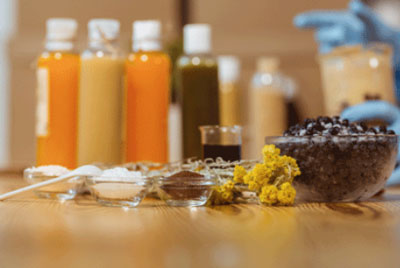Shampooing and applying a mask, spritzing a little hairspray before heading out to eat is all well and good, but how can you be sure it's really healthy? Our Clean Beauty tips... Without splitting hairs.

It's true, there are many components to avoid in the vast range of hair care products that you love so much. And it's not easy to remember the long list of these components to avoid. All hair care brands have launched, with varying degrees of success, into the race for "green". Sophie Macheteau, a specialist in natural cosmetics and founder of the blog suzanegreen.com, gives us an update to sort out the truth from the lies, find out which components to avoid, smart alternatives and Clean homemade recipes .
What ingredients should be avoided in shampoos and hair care products?
The list is unfortunately very long!
First of all, I recommend banning shampoos with sulfates : mainly sodium lauryl sulfate (SLS) and sodium laureth sulfate (SLES). Sure, they create a nice lather, but they are aggressive and drying for the hair. Fortunately, there are now many sulfate-free formulas for the happiness of our hair! Also avoid formulas containing mineral oils (from petrochemicals such as paraffin), silicones and polymers (dimethicone, amodimethicone, acrylates crosspolymer) which gradually suffocate the hair, weaken it and make it more brittle. These synthetic compounds are non-renewable and non-biodegradable sources. Not great for the planet!
Methylisothiazolinone (MIT) and methylchloroisothiazolinone (MCI) should also be avoided, as they can cause serious skin allergies. And of course, avoid formulas with parabens , suspected of being endocrine disruptors , as well as synthetic fragrances and dyes that contain many allergens.
So what are the alternatives in terms of components?

For shampoos, it is better to turn to gentle formulas without sulfates and organic (certified or not, but in this case, you need to know the brand's values). Whatever the care, avoid formulas that are too long, which can turn into a real "allergenic cocktail". Bet on brands that turn to plants (without greenwashing) and that offer products with natural active ingredients that will take care of your hair (for example, wheat or rice proteins, plant oils and ceramides, plant silicone from algae, etc.).
What are your essential and simple “homemade” recipes?

The basis of hair care is shampoo. For people who want to prepare it themselves, I recommend using a neutral organic, vegan and palm-free shampoo base, in which it will be possible to add 1 or 2 natural hair active ingredients: for example, plant-based salicylic acid in case of dandruff, vital maca in case of limp hair, bisabolol in case of itching. Personally, I prefer to make powder shampoos (very ecological because they are water-free) using plant powders that naturally contain saponins (molecules with natural surfactant properties that are similar to soap) such as shikakai, the famous Ayurvedic "shampoo plant". I combine shikakai with plant powders that provide hair care. For example, reetha for its detoxifying and purifying effect, neutral henna which detangles and boosts shine, amla which strengthens and stimulates growth. The same goes for care.
And what about lacquers?
They are primarily aerosols and that is not very eco-friendly. Hairsprays propel the styling substances of the product into the air, by micro-diffusion, but also the volatile organic compounds, from the propellant gases. This is why it is recommended on the labels to use them in well-ventilated rooms. Which is never a good sign. Definitely prefer styling sprays in natural sprays without gas.
Dyes = asphyxiation?
Yes, permanent or long-lasting hair colors are necessarily aggressive for the hair and scalp. They generally contain p-phenylenediamine, which is sensitizing and irritating. The alternative is to use plant-based colors that cover gray hair less well but are incomparably greener.
As a general rule, remember that the ingredients that appear at the beginning of the list of components on the labels are the most present in the formula, even if the percentages are not specified. So, open your eyes and be demanding, without losing sight of the pleasure of caring for your hair.










